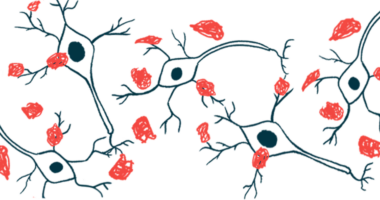Circulating small vesicles reflect Parkinson’s-related brain changes
Alpha-synuclein in its toxic oligomer form in EVs was higher in patients

Small vesicles that contain the protein alpha-synuclein may help distinguish Parkinson’s disease patients from healthy people, according to a meta-analysis.
When isolated from easily accessible samples, like the blood, these vesicles may “reflect changes in the brain,” researchers wrote in “Extracellular Vesicles for the Diagnosis of Parkinson’s Disease: Systematic Review and Meta-Analysis,” which was published in Movement Disorders.
Parkinson’s disease is caused by alpha-synuclein protein accumulating and aggregating in certain brain cells, forming structures called Lewy bodies. These Lewy bodies disrupt normal brain function and lead to the loss of dopamine-producing neurons in the brain, resulting in a shortage of the chemical messenger and causing the disease’s characteristic symptoms.
A Parkinson’s diagnosis is achieved after evaluating for motor symptoms, along with neuroimaging scans and invasive brain and spinal fluid tests.
But symptoms usually take years to develop, by which time available treatments are likely less effective. For this reason, noninvasive tests that accurately detect the disease at early stages may greatly improve outcomes.
Most cells produce extracellular vesicles, or EVs, including the cells of the central nervous system (CNS, brain and spinal cord). EVs are tiny sacs released into body fluids — such as the blood and the cerebrospinal fluid (CSF) — that carry cargo like proteins, DNA and RNAs and help coordinate cell-to-cell communication. The CSF is the liquid that surrounds the brain and the spinal cord.
Differences in extracellular vesicles
A team led by researchers at the University Medical Center Goettingen, Germany conducted a systematic review and meta-analysis of published studies that analyzed EVs from Parkinson’s and healthy people, who served as controls.
Their search covered three databases — PubMed, Web of Science, and Google Scholar – and 62 studies, published through November 2022, were included. Most of the studies were from Asia (34), Europe (19), and North America (10).
All except 13 reported the participants’ age, with a mean age at sample collection of 64.74 for healthy controls and 67.16 for patients. Disease onset occurred at a mean age of 61.26 and the mean disease duration was 5.58 years.
Most studies isolated EVs from different components of blood samples, either plasma (35 studies) or serum (15), or urine (eight), CSF (six) and saliva (two). Plasma is the liquid component of blood that remains after the blood cells (red blood cells, white blood cells, and platelets) are removed, while serum is the clear, straw-colored liquid that remains after blood coagulates and the clot or blood cells are removed.
The analyzed biomarkers were mainly proteins. Of 24 studies, all reported data on total alpha-synuclein, while 11 reported on toxic forms of it (oligomeric alpha-synuclein and phosphorylated Ser129 alpha-synuclein). Five studies reported data on leucine-rich repeat kinase 2 (LRRK2), a protein whose mutations are associated with Parkinson’s. Some studies assessed other proteins, but only biomarkers reported in more than three studies were included in the analysis.
RNA biomarkers from EVs were reported in 15 studies, mostly microRNAs (miRNAs), small molecules that regulate the activity of other genes. The use of miRNAs as potential blood biomarkers has been proposed for several diseases, including Parkinson’s.
There were no changes in total EVs isolated from the blood of Parkinson’s patients and healthy controls. However, EVs secreted from nerve cells, as identified by the presence of the L1 cell adhesion molecule (L1CAM) protein, were significantly higher in Parkinson’s patients. L1CAM plays a key role in the nervous system’s development. This was only seen for EVs isolated from plasma, not serum samples.
Quantifying alpha-synuclein in EVs released from nerve cells was the best method to identify and distinguish Parkinson’s patients from healthy controls.
Also, alpha-synuclein in its oligomer form – a particularly toxic form of the protein – showed significantly higher levels in Parkinson’s patients than controls, irrespective of their origin and sample used for isolation.
No changes were seen between both groups in the total levels of LRRK2 from urine samples.
The findings suggest total alpha-synuclein in EVs from nerve cells is a “promising biomarker,” the researchers wrote. The levels of oligomeric alpha-synuclein were higher in EVs irrespective of their origin and type of sample, suggesting it as “a more robust biomarker.”
“Identifying novel targets is important for diagnosis and mechanistic studies as the EV cargo reflects the content of the cell of origin and can shed light on overseen mechanisms,” the researchers said.







